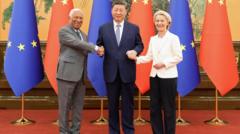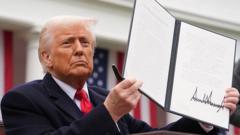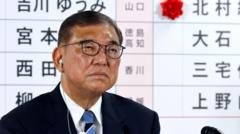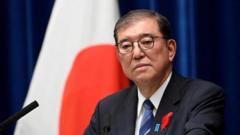The agreement, while touted as monumental, raises questions about its broader implications for Asia and the global market landscape.
**Understanding the Significance of the US-Japan Trade Agreement on Global Dynamics**
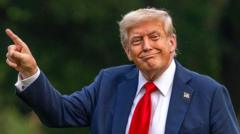
**Understanding the Significance of the US-Japan Trade Agreement on Global Dynamics**
The recent trade deal between the United States and Japan marks a pivotal moment in international trade relations, bringing potential shifts in economic alliances.
The agreement struck between the United States and Japan has been described by US President Donald Trump as a potentially historic trade deal, though such claims may reflect a degree of optimism. This landmark agreement comes on the heels of the tensions stirred by Trump's earlier tariff announcements, which sent shockwaves through global markets. Following extensive negotiations, Japanese Prime Minister Shigeru Ishiba expressed confidence that this deal could benefit the global economy, but the ramifications warrant a closer look.
Japan, as the world’s fourth-largest economy, plays a substantial role in international trade, with significant reliance on imports for energy and food, alongside major exports in electronics, machinery, and automobiles. The US serves as Japan’s largest export market, making the stakes particularly high. Some analysts had warned that previous tariffs could push Japan towards recession. The new agreement aims to alleviate some of those pressures by reducing tariffs, enabling Japanese exporters to enter the US market at lower costs, compared to previously threatened higher tax rates.
Additionally, the recent deal has had a favorable impact on the Japanese yen, enhancing purchasing power for Japanese manufacturers needing raw materials for production. Specifically benefiting automotive giants like Toyota, Honda, and Nissan, the agreement reduces car import duties from an alarming 27.5% down to 15%, which could position Japanese vehicles as more competitively priced than other market players, particularly from China. Domestic American automakers, however, have voiced dissatisfaction over the deal, particularly due to a continued 25% tariff on imports from their manufacturing plants in Canada and Mexico.
In exchange for tariff reductions, Japan has committed to a significant investment of $550 billion into the US market, aiming to bolster resilient supply chains within crucial sectors like pharmaceuticals and semiconductors. This level of investment is expected to create jobs and stimulate innovation. Furthermore, Japan's commitment to increase imports of American agricultural products, including rice, could alleviate US supply shortages but may provoke concerns among local farmers over potential market share losses.
The deal sends a signal to other Asian nations, particularly as countries like South Korea and Taiwan navigate their own trade negotiations with the US. The reduced tariffs become de facto benchmarks as these economies assess their positions in ongoing talks. In response, South Korea's industry minister indicated a keen interest in the US-Japan deal's terms during his upcoming negotiations in Washington.
However, smaller economies such as Cambodia, Laos, and Sri Lanka may find themselves at a disadvantage, struggling to offer competitive concessions to the US. The implications extend beyond economic interests, as the deal’s announcement coincided with Japan and Europe reaffirming collaboration on confronting economic coercion and addressing inequitable trade practices.
In a complex landscape, the US has maintained its stance on steel and aluminum tariffs, continuing to place pressure on Japan while seeking to finalize as many trade agreements as possible before an impending deadline on August 1. With regional dynamics shifting, countries may start looking towards more stable partners beyond the US and Japan.
In summary, while the US-Japan trade agreement may present certain advantages and instill confidence in markets, its true impact on global trade dynamics will take time to unfold, as countries assess their strategies and alliances in an increasingly interconnected economic environment.
Japan, as the world’s fourth-largest economy, plays a substantial role in international trade, with significant reliance on imports for energy and food, alongside major exports in electronics, machinery, and automobiles. The US serves as Japan’s largest export market, making the stakes particularly high. Some analysts had warned that previous tariffs could push Japan towards recession. The new agreement aims to alleviate some of those pressures by reducing tariffs, enabling Japanese exporters to enter the US market at lower costs, compared to previously threatened higher tax rates.
Additionally, the recent deal has had a favorable impact on the Japanese yen, enhancing purchasing power for Japanese manufacturers needing raw materials for production. Specifically benefiting automotive giants like Toyota, Honda, and Nissan, the agreement reduces car import duties from an alarming 27.5% down to 15%, which could position Japanese vehicles as more competitively priced than other market players, particularly from China. Domestic American automakers, however, have voiced dissatisfaction over the deal, particularly due to a continued 25% tariff on imports from their manufacturing plants in Canada and Mexico.
In exchange for tariff reductions, Japan has committed to a significant investment of $550 billion into the US market, aiming to bolster resilient supply chains within crucial sectors like pharmaceuticals and semiconductors. This level of investment is expected to create jobs and stimulate innovation. Furthermore, Japan's commitment to increase imports of American agricultural products, including rice, could alleviate US supply shortages but may provoke concerns among local farmers over potential market share losses.
The deal sends a signal to other Asian nations, particularly as countries like South Korea and Taiwan navigate their own trade negotiations with the US. The reduced tariffs become de facto benchmarks as these economies assess their positions in ongoing talks. In response, South Korea's industry minister indicated a keen interest in the US-Japan deal's terms during his upcoming negotiations in Washington.
However, smaller economies such as Cambodia, Laos, and Sri Lanka may find themselves at a disadvantage, struggling to offer competitive concessions to the US. The implications extend beyond economic interests, as the deal’s announcement coincided with Japan and Europe reaffirming collaboration on confronting economic coercion and addressing inequitable trade practices.
In a complex landscape, the US has maintained its stance on steel and aluminum tariffs, continuing to place pressure on Japan while seeking to finalize as many trade agreements as possible before an impending deadline on August 1. With regional dynamics shifting, countries may start looking towards more stable partners beyond the US and Japan.
In summary, while the US-Japan trade agreement may present certain advantages and instill confidence in markets, its true impact on global trade dynamics will take time to unfold, as countries assess their strategies and alliances in an increasingly interconnected economic environment.

